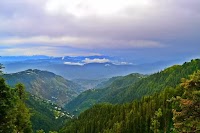Nanga Parbat (literally, Naked Mountain), is the ninth highest mountain in the world and the western anchor of the Himalayas. Located in Gilgit-Baltistan region of Pakistan, Nanga Parbat is one of the eight-thousanders, with a summit elevation of 8,126 metres (26,660 ft). An immense, dramatic peak rising far above its surrounding terrain, Nanga Parbat has not only proved difficult to climb, but also has a notable incidence of tragedy associated with its climbing.
Nanga Parbat forms the western anchor of the Himalayan Range and is the westernmost eight-thousander. It lies just south of the Indus River in the Astore District of Gilgit–Baltistan in Pakistan. Not far to the north is the western end of the Karakoram range.
| NANGA PARBAT (8126m) | ||
| Altitude: | 8126m | |
| Base Camp Altitude: | 4300m | |
| Location: | WESTERN HIMALAYA | |
| Range: | HIMALAYA | |
| Ideal Duration: | 50 Days | |
| Best Time: | May - July | |
| No of Camps Required: | 04 | |
The Himalayas are a great mountain range formed by the collision of Indo- Pakistan tectonic plate with the Asian Continent. The central Himalayan mountains are situated in Nepal, while the eastern mountains extend to the borders of Bhutan and Sikkim.
Nanga Parbat massif is the western corner pillar of the Himalayas. It is an isolated range of peaks just springing up from nothing, and is surrounded by the rivers Indus and Astore. Nanga Parbat or "Nanga Parvata" means the naked mountain. Its original and appropriate name, however, is Diamir the king of the mountains.
Nanga Parbat (main peak) has a height of 8,126m/26,660 ft. It has three vast faces. The Rakhiot (Ra Kot) face is dominated by the north and south silver crags and silver plateau; the Diamir face is rocky in the beginning. It converts itself into ice fields around Nanga Parbat peak. The Rupal face is the highest precipice in the world. Reinhold Messner, a living legend in mountaineering from Italy, says that "every one who has ever stood at the foot of this face (4,500m/14,764ft) up above the 'Tap Alpe', studied it or flown over it, could not help but have been amazed by its sheer size; it has become known as the highest rock and ice wall in the world!".
Nanga Parbat has always been associated with tragedies and tribulations until it was climbed in 1953. A lot of mountaineers have perished on Nanga Parbat since 1895. Even today it is claiming a heavy toll of human lives for, the mountaineers, in search of adventure and thrill, are becoming its victims in pursuit of their eagerness to find new and absolutely un-climbed routes leading to its summit.
It was in 1841 that a huge rock-slide from the Nanga Parbat dammed the Indus river. This created a huge lake, 55 km long, like the present Tarbela lake down-stream. The flood of water that was released when the dam broke caused a rise of 80 ft in the river's 3 level at Attock and swept away an entire Sikh army. It was also in the middle of the nineteenth century that similar catastrophes were later caused by the damming of Hunza and Shyok rivers.
The Nanga Parbat peak was discovered in the nineteenth century by Europeans. The Schlagintweit brothers, who hailed from Munich (Germany) came in 1854 to Himalayas and drew a panoramic view which is the first known picture of Nanga Parbat. In 1857 one of them was murdered in Kashgar. The curse of Nanga Parbat had begun.
Nanga Parbat massif is the western corner pillar of the Himalayas. It is an isolated range of peaks just springing up from nothing, and is surrounded by the rivers Indus and Astore. Nanga Parbat or "Nanga Parvata" means the naked mountain. Its original and appropriate name, however, is Diamir the king of the mountains.
Nanga Parbat (main peak) has a height of 8,126m/26,660 ft. It has three vast faces. The Rakhiot (Ra Kot) face is dominated by the north and south silver crags and silver plateau; the Diamir face is rocky in the beginning. It converts itself into ice fields around Nanga Parbat peak. The Rupal face is the highest precipice in the world. Reinhold Messner, a living legend in mountaineering from Italy, says that "every one who has ever stood at the foot of this face (4,500m/14,764ft) up above the 'Tap Alpe', studied it or flown over it, could not help but have been amazed by its sheer size; it has become known as the highest rock and ice wall in the world!".
Nanga Parbat has always been associated with tragedies and tribulations until it was climbed in 1953. A lot of mountaineers have perished on Nanga Parbat since 1895. Even today it is claiming a heavy toll of human lives for, the mountaineers, in search of adventure and thrill, are becoming its victims in pursuit of their eagerness to find new and absolutely un-climbed routes leading to its summit.
It was in 1841 that a huge rock-slide from the Nanga Parbat dammed the Indus river. This created a huge lake, 55 km long, like the present Tarbela lake down-stream. The flood of water that was released when the dam broke caused a rise of 80 ft in the river's 3 level at Attock and swept away an entire Sikh army. It was also in the middle of the nineteenth century that similar catastrophes were later caused by the damming of Hunza and Shyok rivers.
The Nanga Parbat peak was discovered in the nineteenth century by Europeans. The Schlagintweit brothers, who hailed from Munich (Germany) came in 1854 to Himalayas and drew a panoramic view which is the first known picture of Nanga Parbat. In 1857 one of them was murdered in Kashgar. The curse of Nanga Parbat had begun.





